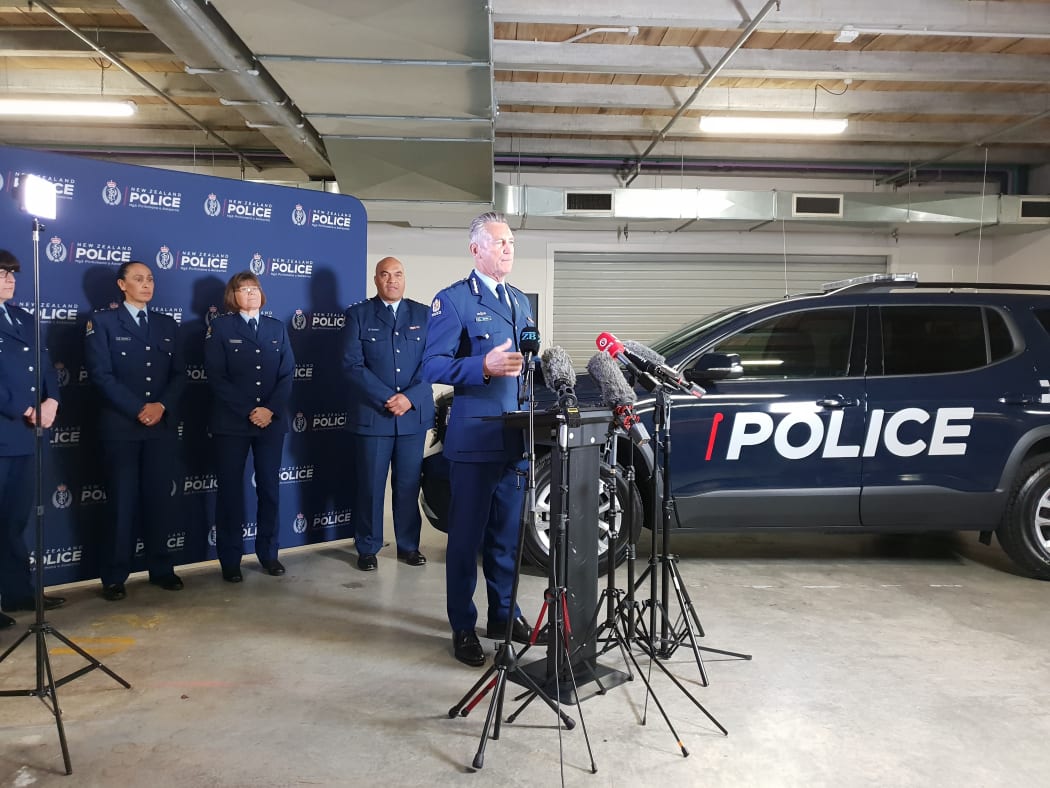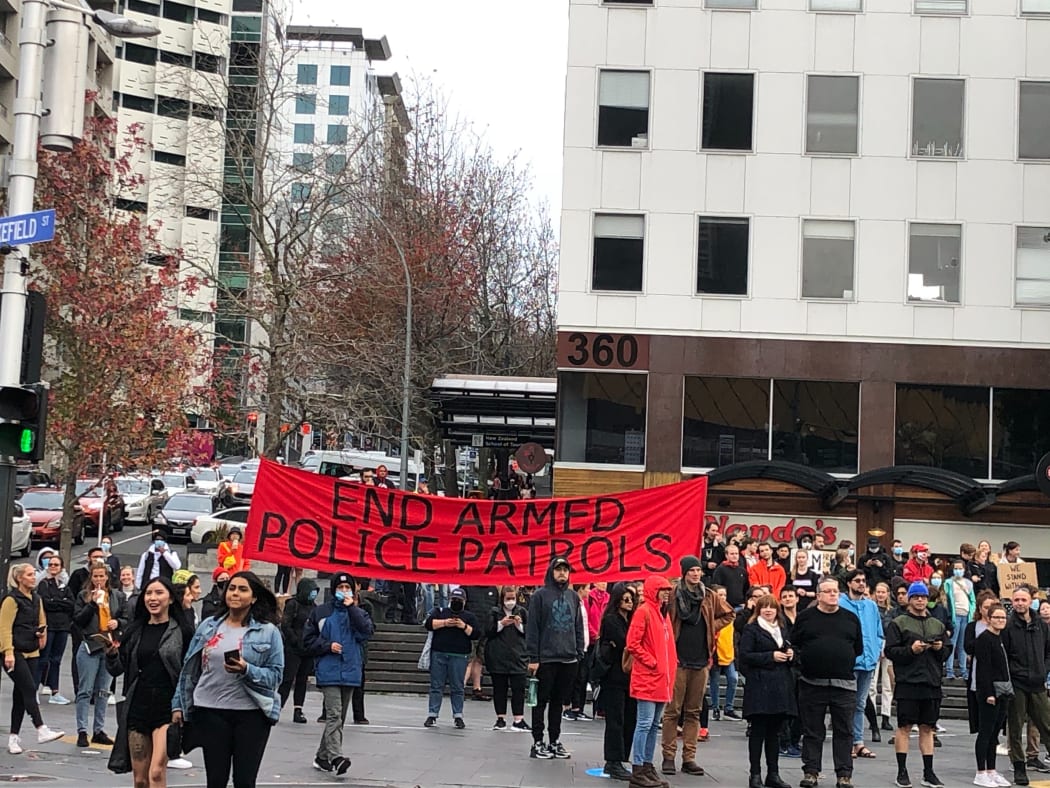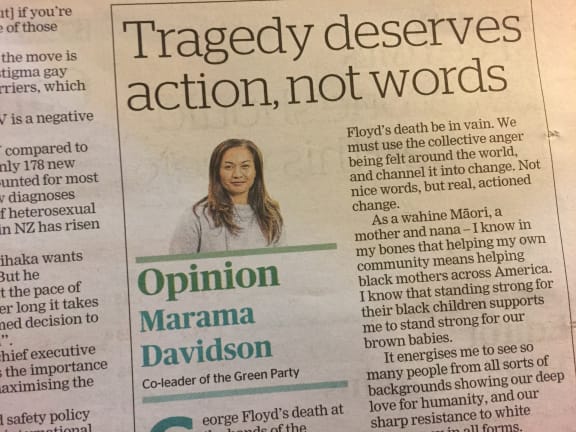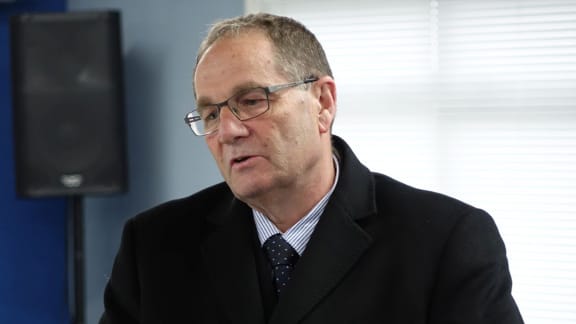This week, the police canned its controversial Armed Response Teams after plenty of critical coverage in the media - much of it drawing parallels with George Floyd’s killing in the US and the conduct of armed cops there.
But did we get a full picture of how and why our police bear arms in the first place?

Former Police Commissioner Mike Bush and an ART vehicle in the background Photo: RNZ / Liu Chen
“I was clear from the outset that it wouldn’t just be an evaluation what would answer this question.We’ve listened to what communities have said - hence this decision,” Police Andrew Coster said, pulling the pin on the controversial armed response teams on Tuesday.
Police had previously said they’d wait until a full evaluation of this initiative - which was due to be completed by the end of this month. Data released on Wednesday confirmed the suspicions of those opposed to the trial - Māori made up more than 50 percent of arrests and uses of force by the teams.
It’s a strange sort of trial which ends after six months, then another two months go by before it all comes to an end based on the public response - with the full evaluation of it yet to see the light of day.
Police Commissioner Andrew Coster also said the main reason for his decision was that the armed teams “didn't align with the style of policing New Zealanders expect”.
The Commissioner’s captain call didn’t end the intense opposition to arming police.
When he told RNZ’s Morning Report the next day he would investigate “less lethal” means such as sponge bullets - the sort of things used for crowd control in US protests recently - campaigners opposed to the ARTs said this was more ‘militarisation'.
During the debate about ARTs it was not often mentioned that most patrol cars have guns in a locked box in case officers needed to use them. There were no complaints about armed police when Brenton Tarrant was arrested at gunpoint in Christchurch on March 15 2019 by officers who happened to be returning from firearms training.
But another shocking story changed the backdrop to the debate recently: the death of George Floyd in Minneapolis and the violent confrontations with armed police that followed in the US.

Photo: RNZ / Mabel Muller
Rates of arrests, imprisonment and instances of people harmed by police are all disproportionately high for Māori and Pasifika people.
Many people who took part in Black Lives Matter marches here the weekend before last were protesting about arming our police.
The fact that a clumsily-worded social media message from the Greens’ justice spokesperson ended up on TVNZ’s 6 o’clock news showed how sensitive the issue had become.“
"To use the death of Mr Floyd . . . to make claims about New Zealand police discrimination... is offensive to officers who work in some of the most difficult, violent and fractured communities in our country," Police Association president Chris Cahill complained later.
In a column for the Sunday Star Times, Green co-leader Marama Davidson said tensions escalated in the areas covered by the ARTs during the trial.
“As a mother of two Māori boys living in one of those areas, I can attest to that tension first hand” she wrote, adding that grief over George Floyd here should be channeled into opposing arms for police.

Green co-leader Marama Davidson in the Sunday Star Times last weekend. Photo: photo / RNZ Mediawatch
But while there was plenty of opposition to the trial of ARTs voiced in the media, there haven’t always had the many specifics about them in media reports.
The trials launched last year in Counties Manukau, Waikato and Canterbury were wrapped up six months later last April.
But long before the official evaluation, the media were exposing its flaws.
On 5 June, RNZ reported ART officers failed to keep proper records of almost all their callouts.
In late May, RNZ’s Checkpoint revealed rushed decision making and inadequate consultation, especially with Māori. Those are serious flaws in light of Treaty obligations.
Three days later the Newsub Nation show on Three revealed the ART actually did mainly routine work, like traffic stops, bail checks and attending accidents.
"One of the concerns . . . was they would be an introduction of armed units into routine policing by stealth, and looking at the data that's emerged those fears seem to be realised," former South Auckland police detective turned investigator and campaigner Tim McKinnel told Newshub Nation.
In a piece for the Māori current affairs site E-Tangata, Arms and Race, he called the ART trial “opportunism,” and an egregious example of policing by decree, rather than consent.”
“I know, and work in, communities where the feeling is that we are much closer to the precipice than we care to admit,” he said.
The Greens’ Golriz Gharaman tweeted “We won!” and “communities are safer” as a result.
But which communities?
Police Association Chris Cahill subsequently told Stuff the Green Party MPs’ had ignored the proliferation of illegal weapons in homes, in vehicles and used in robberies and gang warfare.
Not only were firearms attacks on police officers at an all-time high, he said in the past three years there were eight fatal shootings in Counties Manukau alone - one of the communities where the Green MPs claim the ARTs would have a negative effect.
“Bad people have guns sometimes and we want a police force that able to deal with them promptly, don't we?,” Kim Hill asked Auckland councillor for the Manukau ward Efeso Collins on RNZ’s Morning Report.
In mid-May RNZ, reporter Ben Strang discovered gun crime and deaths involving firearms were going up, but there had not been a corresponding increase in officers taking out or using their guns.
Alarm about the prospect of routinely-armed officers patrolling areas deemed to be highest risk is understandable - especially for Māori and Pasfika people in those areas who are statistically far more likely to encounter those armed officers.
And those who fear armed police teams routinely on the road won't make our communities any safer may be right, but facts like that were missing from condemnations of the ART trial in the media - made at time when fears and anger about it are heightened because of outrage over George Floyd and the Black Lives Matter protests in the US.

Whanganui MP Chester Borrows Photo: RNZ
Chester Borrows is a former policeman who won a medal for confronting an armed murderer in 1979. He later became an associate Minister of Justice in the National-led government.
He was the chair of Safe and Effective Justice Advisory Group, Te Uepū Hāpai i te Ora, tasked with helping reform New Zealand's criminal justice system.
Did the intensity of the criticism of the armed response teams in the media play a part in the the decision to end them?
"I think there’s been a definite skew in the reporting of the ARTs. We’ve had a whole lot of comment from those who are against and that’s had its effect. There's stuff there that needs more investigation and it’s quite a complex issue," he said.
'What media profile does is animate others - and he would’ve had some fairly clear responses from people around the country whether it be members of the public, activists, journalists or MPs and members of the Cabinet,“ he said.
“I think it’s probably prompted the early decision I’m not sure if it would’ve just affected the decision itself had more time been given to it," he told Mediawatch.
“I don’t think it has been balanced - but that hasn’t bothered me too much because it’s been in favour of my argument - and that’s the way most of us view media reporting," he said.
“New Zealanders understand the threats are greater against the police - and against each other - then they’ve been before and we need to be able to combat that. No one is saying the police shouldn’t be armed but they don’t want to see a country where police are walking around with firearms on their hips in full view all the time,“ he said.
“People in New Zealand are largely ignorant of the fact that a large proportion of the police driving past them have got a firearm in the car available for use almost immediately. They rest in the comfort of thinking that our police services are unarmed," he said.
"We haven’t heard a lot of voices of those in favour of ARTs. Unfortunately as soon as some air is given to that side of the argument the nutbars come out using rhetoric and not data or logic in their arguments. The voices of reason that have a different point of view - like Chris Cahill - get drowned out,“ he said.

